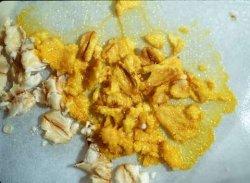slime mold

Figure 1. Cellular slime mold life cycle.

Figure 2. Slime before (left) and after (right) negotiating a maze.
Slime mold is any of several hundred primitive heterotrophic organisms that superficially resemble fungi, and were once grouped with them, but are now classified as protists. Like animals and plants, slime molds are eukaryotes. They are found in forests and other locations throughout the world.
Slime molds have complex life cycles that may be divided into an animallike motile phase, in which growth and feeding occur, and a plantlike, immotile, reproductive phase. The motile phase is commonly found under rotting logs and damp leaves, where cellulose is abundant. There are two major groups, the plasmodial slime molds and the cellular slime molds, which differ most notably in their behavior in the motile phase.
Plasmodial slime molds
Plasmodial slime molds, of the phylum Myxomycota, are basically enormous single cells with thousands of nuclei. About 500 species are known. Plasmodial slime molds are formed when individual flagellated cells swarm together and fuse. The result is one large bag of cytoplasm with many diploid nuclei. In the motile phase, this multinucleate, or coenocytic, mass, called a plasmodium, creeps about by amoeboid movement.

|
| Figure 3. The plasmodial slime mold Physarum
|
Plasmodia may grow to a diameter of several inches and are often brightly colored. They feed on living microorganisms, such as bacteria and yeasts, as well as decaying vegetation, ingesting solid food particles by a process called phagocytosis. Before entering the reproductive stage, a plasmodium moves to a drier, better-lit place, such as the top of a log. In the reproductive stage the plasmodium is transformed into one or more reproductive structures called fruiting bodies, each consisting of a stalk topped by a spore-producing capsule that resembles the reproductive structures of many fungi. Eventually the cellulose-walled spores are released and dispersed; they germinate in wet places, releasing naked cells. In a typical plasmodial slime mold the germinated spores go through an amoeboid or flagellated swimming stage, followed by sexual fusions and cell divisions. The diploid ameboid cell (i.e., the zygote) grows and its nucleus divides repeatedly, resulting in the formation of a new plasmodium. Under adverse conditions a plasmodium may be transformed into a hard, dry, inactive mass called a sclerotium. Resistant to desiccation, it becomes a plasmodium again when favorable conditions return.
The "giant cells" of plasmodial slime molds have proved to be extremely useful in studies of cytoplasmic streaming (the movement of cell contents) because it is possible to see this happening even under relatively low magnification. In addition, becauae of their large size, slime mold "cells" are easier to manipulate than most other kinds of cells.
Cellular slime molds
The second group of slime molds are the cellular slime molds of the phylum Acrasiomycota, of which about 65 species are known. These spend most of their lives as separate amoeboid cells; however, upon the release of a chemical signal, the individual cells aggregate into a great swarm (Figure 1). Up to 125,000 individual cells aggregate and flow together, forming a multicellular mass called a pseudoplasmodium that resembles a slug and crawls about ingesting food in the same way as a plasmodial slime mold, before settling in a location with acceptable warmth and brightness. Each of the spores released from a fruiting body develops becomes a single amoeboid cell, feeding individually until starving cells release a chemical signal that causes them to aggregate into a new pseudoplasmodium, and the process is repeated. In sexual reproduction, two haploid amoeboid cells fuse, then engulf surrounding amoeboids to form a single organism called a macrocyst. The macrocyst then undergoes meiosis and mitosis and releases haploid individuals.
Cellular slime molds are of great interest to cell and developmental biologists because they provide a comparatively simple and easily manipulated system for understanding how cells interact to generate a multicellular organism. There are two groups of cellular slime molds, the Dictyostelida and the Acrasida, which may not be closely related to each other.
Slime molds have, not surprisingly, left almost no fossil record. Not only do slime molds produce few resistant structures (except for spores, which are often overlooked or unidentifiable), but they live in moist terrestrial habitats, such as on decaying wood or fresh dung, where their potential for preservation is low. A few fossil slime molds have been found in amber.
A group of organisms known as slime nets, belonging to the phylum Labyrinthulomycota, are also sometimes called slime molds. However, they appear to be more closely related to the Chromista, and are not relatives of the two genuine slime mold groups.
A-mazing slime mold
In 2000, a team of Japanese and Hungarian researchers, writing in the journal Nature,1 claimed to have demonstrated that the slime mold Physarum polycephalum is capable of finding the shortest way through a maze (Figure 2). Pieces of the slime mould were enticed through a 30-square-centimeter (5-square-inch) maze by the prospect of food at the end of the puzzle. The researchers concluded that the creature was exhibiting a kind of primitive intelligence.
Toshiyuki Nakagaki of the Bio-Mimetic Control Research Centre, Nagoya, Japan, placed pieces of Physarum polycephalum in an agar gel maze comprising four possible routes. Normally, the slime spreads out its network of tube-like legs, or pseudopodia, to fill all the available space. But when two pieces of food were placed at separate exit points in the labyrinth, the organism squeezed its entire body between the two nutrients. It adopted the shortest possible route, effectively solving the puzzle.
The organism changed its shape, according to the researchers, to maximize its foraging efficiency and therefore its chances of survival. The meal of ground oat flakes led to a local increase in contraction of the organism's tube-like structures, propelling it towards the food.
Slime-bot
Physarum polycephalum also serves as the brain of a six-legged robot developed at the University of Southampton, England. The slime mold, which naturally shies away from light, controls the robot's movement so that it too keeps out of light and seeks out dark places in which to hide itself. Klaus-Peter Zauner who developed the slime-controlled bot with colleagues from Kobe University in south-central Japan, says the idea is to find simpler ways to control a robot's behavior. They grew the slime in a six-pointed star shape on top of a circuit and connected it remotely, via a computer, to the hexapod bot. Any light shone on sensors mounted on top of the robot were used to control light shone onto one of the six points of the circuit-mounted mold, each corresponding to a leg of the bot. As the slime tried to get away from the light its movement was sensed by the circuit and used to control one of the robot's six legs. The robot then scrabbled away from bright lights as a mechanical embodiment of the mold.
 |
| Fig 4. Slime-mold controlled robot |
Return of the Blob
In 1973, a Dallas resident went out to the backyard only to stumble upon a reddish, jelly-like mass pulsating in the grass. News reports on the discovery claimed that a "new life form" had been found, and many people couldn't help recalling the cult classic sci-fi thriller The Blob. Scientists called to the scene, however, put any fears of menacing goo or alien creatures to rest by identifying the mass as an unusually large (46 centimeters diameter) plasmodial slime mold.
Reference
1. Nakagaki, T., et al. "Maze-solving by an amoeboid organism," Nature, 407: 470 (2000).


